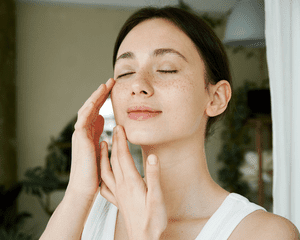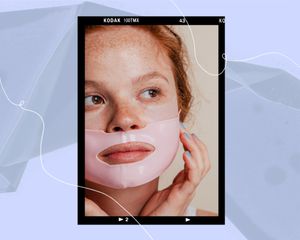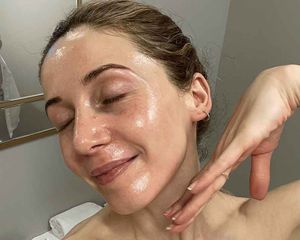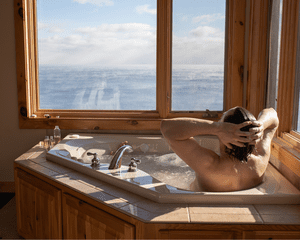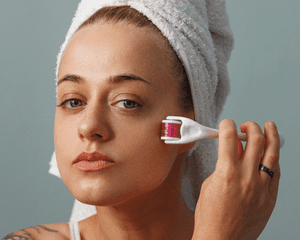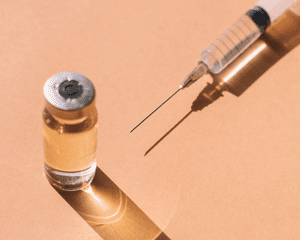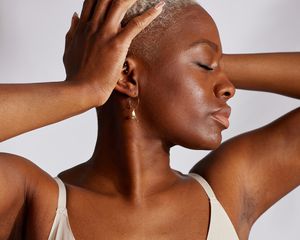:max_bytes(150000):strip_icc()/cdn.cliqueinc.com__cache__posts__232263__first-chemical-peel-tips-232263-1502461307907-main.700x0c-8f58a9438eb84ec2b86e33764d02c16e-2444a8b3aa304444b8630da0959c7d90.jpg)
Dacy Knight Image by Byrdie
Before moving to L.A., I had never heard the word "ashwagandha," never tasted a matcha latte, had no concept of getting a shot for the sake of beauty, and I had a skincare regimen that consisted of washing my face (most nights). During my assimilation to the Southern California lifestyle, I've learned that good skin requires more than just removing your makeup nightly, and I've gotten on board with some of the holistic approaches that prioritize beauty from the inside out.
When I was offered the opportunity to experience an On the Glow facial from board-certified plastic surgeon John Diaz, MD—a triptych of three treatments I can only describe as "super L.A."—I was excited to try it. I had never had a facial peel, and my only introduction to B12 shots was hearing about "intravenous vitamin cocktails" in a British Vogue video on L.A., or the Wellness Capital of the World. Plus, who doesn't love LED light therapy (the third component of the treatment)?
Visiting Diaz's office was my first visit to a plastic surgeon and my first time getting a real beauty treatment. Prior to my visit, I googled what I should do (and avoid) to prepare for my first facial peel, but the answers were mixed and even borderline intimidating (one noted to not wear nice clothes, as the chemicals could ruin them).
Once I took a seat at my facial treatment, my concerns and questions were quickly addressed. Diaz walked me through each part of the procedure, explaining not only what was at work but what benefits to expect in the following days and even weeks. The treatment took less than a half-hour, and the process was much less intimidating than I had anticipated. As a newbie to the experience, I inundated Diaz with a series of questions. Read on for my conversation with Diaz, and to find out what to expect after a chemical peel.
BYRDIE: What should someone know before getting a chemical peel?
JOHN DIAZ: First of all, it's important to make sure they don't have any medical conditions that may prevent treatment with a chemical peel. Women who are pregnant, or are actively trying to get pregnant, for example, should avoid some of the more aggressive peels (as well as anyone with open sores, lesions, or skin infections). Some medications, like Retin-A, or lifestyle factors, like excessive sun exposure, may also determine whether a peel is a good idea for you. We always recommend everyone get a thorough skincare assessment prior to undergoing a peel to make sure you will get the best results possible.
You will notice a visible improvement in your skin after one peel, but best results are obtained with multiple treatments over time.
BYRDIE: What are some common misconceptions about chemical peels?
JD: The most common misconception we hear all the time is that a chemical peel will require a lot of downtime. I have had patients say they are afraid they will look like Samantha after her chemical peel in that Sex and the City episode. Although some high-concentration peels will cause significant redness, we also have mild peels that work great and have minimal downtime.
Another misconception is that you should see a noticeable difference after only one chemical peel. Just as it takes time for skin damage to accumulate, it also takes time to reverse it.
BYRDIE: If someone has troubled skin, are there any treatments they should seek out or avoid?
JD: This depends on which skin problem they have. For example, adult acne is a frustrating and difficult problem. In addition to standard therapies, like benzoyl peroxide and salicylic acid, some mild chemical peels can work great to help prevent breakouts. Also, those with sun damage (textural issues/hyperpigmentation) can benefit from a series of professionally selected peels.
One treatment people with acne should avoid, on the other hand, is self-extractions. It's tempting to try to pop your own pimples, but this often leads to redness, infection, and possible scarring. The same goes for derma-planing and micro-needling if you have active acne, as these treatments can exacerbate the already inflamed skin condition. It's better to leave this to a professional.
BYRDIE: Are there any steps one should take before coming in for a peel?
JD: There are a few general things we encourage everyone to do before and after they have a peel for best results. For example, if you are on Retin-A for severe acne, you should avoid having a peel altogether (especially during the healing process). This medication thins the outer layer of the skin and makes it more difficult for your skin to heal after a peel. Some other medications, like certain antibiotics, make your skin more vulnerable to sun damage and should be avoided before getting a peel. Sun exposure, in general, should be avoided after a peel. Your skin will be more sensitive to damage from UVA and UVB rays after treatment, so using a lot of sunscreen will be essential. Patients or clients should consult with their physicians regarding any contraindications with their medications and getting a peel.
Patients who get vitamin B12 injections often report a boost in their energy level. They will say they feel more focused and productive at work, in addition to feeling more stamina in the gym.
BYRDIE: Can you please describe the On the Glow chemical peel and why it's an effective express option?
JD: The On the Glow treatment is our signature treatment for anyone who wants their skin to look refreshed with no downtime. It consists of three easy steps. The first step is our proprietary chemical peel. This gentle peel superficially exfoliates the skin and reveals smoother and more youthful skin below. The second step is the application of Red and Blue LED light therapy. LED light in the red wavelength has been shown to stimulate collagen production, skin cell growth, and blood flow. LED light in the blue wavelength kills acne-causing bacteria and prevents breakouts. The third and final step is a vitamin B12 injection. This boosts your body's metabolism and promotes a healthier appearance to your skin. Patients will do this treatment a few days before a big party or red carpet event to look their best.
BYRDIE: What exactly is a B12 shot, and how does it help with one's health and appearance?
JD: Vitamin B12 is one of the essential vitamins our body needs. It is instrumental in helping your body make DNA, nerve cells, and red blood cells. The overall effect is stimulation in cell growth and improved cell function. When someone is deficient in vitamin B12, it can cause fatigue, forgetfulness, and pale skin, in addition to more severe symptoms. Patients who get vitamin B12 injections often report a boost in their energy level. They will say they feel more focused and productive at work, in addition to feeling more stamina in the gym. Lastly, many patients will tell us they see an improvement in the appearance and health of the skin.
BYRDIE: How often would you recommend someone to get each of the three treatments offered in the On the Glow facial? Does it differ depending on age or skin type?
JD: What is great about the On the Glow facial is that it is gentle and can be done on a regular basis. We recommend having it done once a month to maintain a fresh and youthful appearance to the skin. In fact, repeated treatments will stimulate new collagen and skin cell formation so the results are cumulative. We also recommend you have the vitamin B12 injection only once every three to six months.
BYRDIE: How do you suggest clients care for their skin between facials? What does an ideal skincare regimen look like?
JD: This is another common question. We created a skincare system that is easy to follow if your concern is to prevent signs of aging. We call it the Honor System, and it consists of four of our signature products from Honor MD Skincare. The first is Wild Rose Cleanser. This is a gentle hydrating cleanser, which is safe to use pre- and post-peels. Four to five days after having a peel is the ideal time to add the second step called Tropical Mist pH Balancing Toner. Tone consists of a rich combination of botanicals, peptides, and essential nutrients. It works to neutralize and balance the skin's pH. Not only will this help your skin recover after each peel, but it will also create the ideal skin conditions for optimal cell growth and renewal. Once you have started using the toner, you can then add the [third product called Genetically Blessed Super Antioxidant Serum. This is a powerful blend of cat's claw bark, moringa, coffee, and alpha-hydroxy acids. It's designed to gently exfoliate skin and create a brighter-looking complexion. Lastly, finish with Step 4, H(ope)20 Moisturizing Serum, which is a deeply-hydrating hyaluronic acid serum.]
Shop The Look
Up next: Check out Byrdie's complete guide to Botox .

